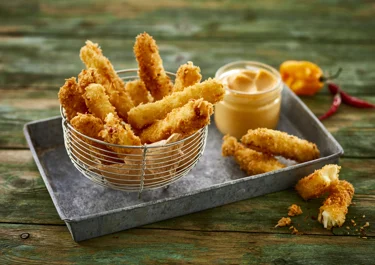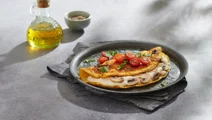
Halloumi fries

Instructions
Recommended information
Serving suggestion
Questions about halloumi fries
Halloumi is deliciously savoury, try our recipe and you will see for yourself! Check below the answers to the frequently asked questions about halloumi fries.
Ingredients
Halloumi fries
Halloumi cheese or grilling cheese | 200 g |
|---|---|
Flour | Approximately 90 g |
Water | 150 ml |
Panko breadcrumbs | Approximately 75 g |
Rapeseed oil | 500 ml |
For serving
Dip (like chillies mayonnaise, tartar sauce, taco sauce or similar) |
|---|
Hall-oumi of fame: the Cypriot heritage of halloumi
History tells us that halloumi was first made on the picturesque island of Cyprus. Dating as far back as the Mediaeval Byzantine period (AD 395 – 867), farmers would add rennet (an enzyme found in the stomachs of herbivorous animals) to sheep’s or goat’s milk and heat it to separate curds and whey. The curds would then be pressed into blocks and cooled before being re-boiled in the whey. To preserve the cheese, the halloumi was soaked overnight in a salty brine and then packed in mint leaves to keep them fresh.
So quintessentially Cypriot, halloumi was awarded Protected Designation of Origin status by the EU. This means that a product sold within EU borders can only be labelled as halloumi if it was produced in Cyprus and followed very specific guidelines.
Five amazing dip sauces
- Tashi: Our first pick is another Cypriot classic known as tashi: a zesty, creamy, and garlicky dip that features tahini, lemon juice, garlic, and a pinch of salt as its star ingredients.
- Sweet chilli sauce: A good quality sweet chilli sauce with its spicy, sweet, and sour notes is a much-loved favourite for many. Available in most stores, this is a near zero-effort sauce that pairs exceptionally well with this recipe.
- Romesco: A smoky, earthy romesco sauce will add a mouth-watering contrast in flavour, texture, and colour.
- Tzatziki: For a fresh and light twist, add a bowl of tzatziki to your mezze platter. The creamy and tangy yogurt, combined with the freshness of the cucumber and saltiness of the cheese is a great match.
- Harissa mayonnaise: Create the perfect blend of creamy, spicy, and salty by mixing together harissa, mayonnaise and lemon juice.
The magic of halloumi fries
While rubbery and squeaky are not the most commonly used words to describe a delicious food, it’s the only way to explain halloumi’s charm and magic. In this recipe, we add crispy perfection to the mix by frying the fritters in vegetable oil. The result is a salty, creamy and yes, rubbery and squeaky dish that will leave no palate unsatisfied.










